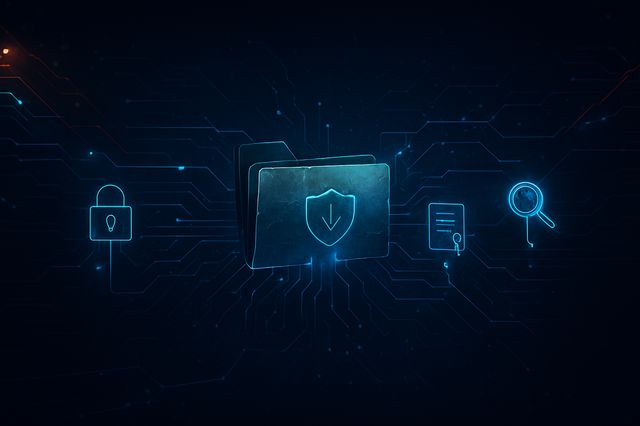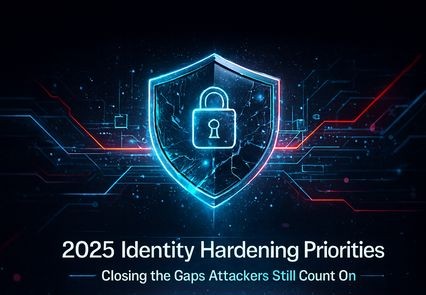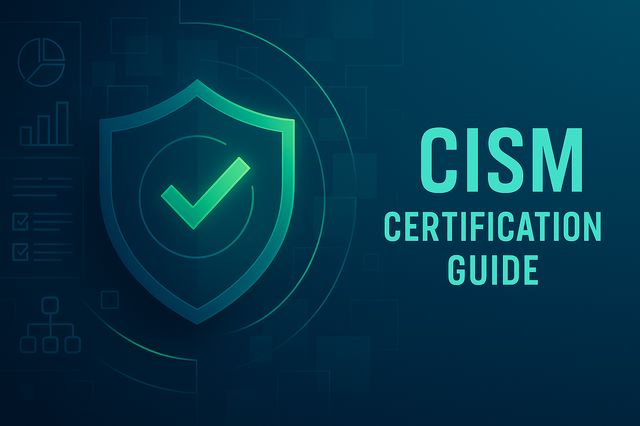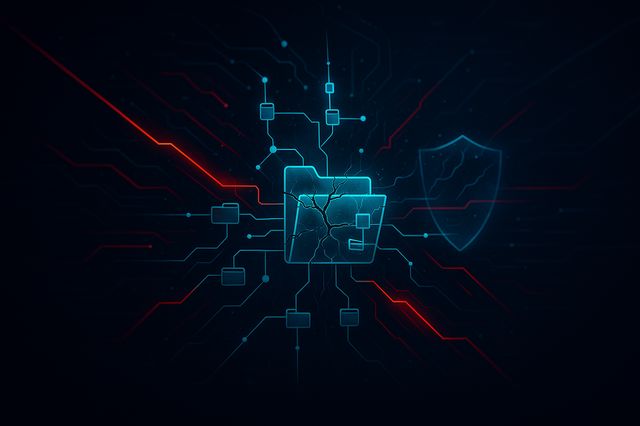
AD Security in 2026 | Strengthening a 25 Year Old Identity System Before It Fails You
Active Directory marks its twenty fifth year as the identity backbone for enterprises worldwide, yet it remains a system deeply anchored in a technological era that no longer exists. Organizations continue to rely on AD because the operational weight of migration, application dependencies, domain-joined infrastructures, and historical processes makes on-prem identity nearly impossible to replace overnight. While cloud identity platforms grow rapidly, AD still authenticates users, controls privileges, distributes policy, and governs access across thousands of business-critical systems. But in 2025, its foundational assumptions collide directly with modern cyber risks. AD was never designed for hybrid networks, global connectivity, remote work, ransomware ecosystems, or adversaries capable of moving laterally at unprecedented speed. Attackers know exactly how AD behaves and exploit the same predictable weaknesses again and again.
“Attackers don’t break Active Directory they simply take advantage of how it has always worked.”
A breach of Active Directory is not a breach of a single system. It is a breach of the entire organization. With domain-level access, attackers can elevate privileges, disable defenses, exfiltrate sensitive data, deploy ransomware at enterprise scale, or rewrite policy for every user and device. This is why identity compromise has become the most destructive category of cyberattacks in the last decade. Securing AD is no longer an enhancement; it is an operational imperative.
Looking to expand your identity security strategy?
Explore our guide: Zero Trust Access Management for SMBs in 2025 a practical roadmap for controlling identity, devices, and privileged access across hybrid environments.

Active Directory in 2025 | A Legacy Architecture Under Modern Pressure
Despite technological evolution, organizations still depend on AD because it remains deeply tied to identity workflows. Many key systems still depend on LDAP or Kerberos. Group Policy remains a central configuration mechanism. Numerous servers and endpoints require domain membership. Hybrid identity still synchronizes through on-prem directory objects. All of this creates an identity layer that is both essential and fragile.
One of the core problems is AD’s default transparency. Any authenticated user can retrieve sensitive structural information about the domain group memberships, trust paths, delegation settings, ACLs, and privileged relationships. This means attackers conducting reconnaissance rarely need to be noisy or use sophisticated exploitation techniques. At the same time, years of operational drift accumulate into misconfigurations that significantly increase exposure. Environments often contain stale user objects, unused computer accounts, legacy trusts, forgotten GPOs, misconfigured service accounts, and over-permissioned administrative groups. These are not theoretical risks they are practical entry points attackers rely on daily.
Legacy protocols make the situation worse. NTLM, unencrypted LDAP, and outdated Kerberos configurations remain common because legacy applications still depend on them. Hybrid identity broadens the blast radius even further by increasing replication, credential flow, and synchronization complexity. Weakness in AD becomes weakness everywhere including in the cloud. And without strong monitoring, organizations fail to detect early indicators of identity abuse. Minimal logging, incomplete audit policies, and limited correlation across events leave a vast blind spot where attackers thrive.
If your AD environment still relies on legacy protocols or outdated infrastructure, you’ll want to read this next:
The Full Essential Guide | Office IT Infrastructure Setup & Cost-Saving Checklist build a secure, scalable foundation that doesn’t leak identity risk.
How Attackers Compromise AD | A Predictable, Structured Process
Most AD breaches follow a pattern that has barely changed for years, because the architecture itself is predictable. It begins with initial access often through compromised credentials obtained via phishing, password spraying, or endpoint exploitation. A single low-privilege account is usually enough to start the chain.
Once inside, attackers map the environment using standard directory queries. They identify where privileges reside, how ACLs are structured, which service accounts can be abused, and which delegation paths lead upward. All of this happens quietly, under the radar.
Privilege escalation is where AD’s age becomes a severe liability. Attackers exploit weak service accounts, Kerberos misconfigurations, token replay opportunities, or insecure delegation. They dump credentials from LSASS, manipulate ACLs to take ownership of privileged objects, or abuse Group Policy to enforce malicious configurations. Any of these vectors can be enough to pivot into domain dominance. After escalation, attackers gain the ability to modify directory objects, establish persistence, disable defenses, reset privileged passwords, and move laterally toward critical assets. The environment becomes theirs.
Active Directory Attack Path
| Attack Method | Description | Weakness Targeted | Outcome |
|---|---|---|---|
| Credential Compromise | Stealing user/service credentials | Weak passwords & reuse | Initial access |
| Kerberoasting | Extracting Kerberos tickets for offline cracking | Weak service account keys | Escalation |
| AS-REP Roasting | Attacking accounts without pre-authentication | Misconfigured user properties | Escalation |
| Pass-the-Hash | Replaying NTLM hashes | Legacy authentication | Lateral movement |
| Pass-the-Ticket | Reusing Kerberos tickets | Weak ticket protection | Privileged access |
| LSASS Dumping | Extracting credentials from memory | Unprotected endpoints | Domain compromise |
| ACL Abuse | Misusing object permissions for takeover | Excessive rights | Privilege escalation |
| Delegation Abuse | Impersonating privileged identities | Broad/insecure delegation | Identity impersonation |
| GPO Manipulation | Injecting malicious policy configurations | Weak GPO permissions | System takeover |
| NTLM Relay | Relaying authentication without cracking | Legacy NTLM exposure | Remote compromise |
Want a deeper breakdown of modern attack vectors?
Our report: How to Defend Against the Top Cyberattacks in 2025 covers the real-world tools, tactics, and defensive controls used by today’s threat actors.
Strengthening Active Directory Without Replacing It
Improving AD security is not about pushing organizations to adopt dozens of new tools or rushing toward cloud-only identity. Instead, it requires restoring architectural discipline and applying modern identity principles to an older platform. Strengthening authentication is the foundation. Organizations must enforce robust password policies, eliminate weak authentication protocols where possible, and isolate privileged accounts from everyday workstations to prevent credential exposure. Service accounts deserve dedicated attention because many inherit excessive rights and rarely have rotating credentials, making them a high-value target.
Reducing identity clutter is another essential step. Years of operational expansion create unnecessary objects and permissions that attackers can weaponize. Removing stale accounts, unused groups, and forgotten privileges reduces the attack surface and increases operational clarity. Rebuilding privilege structures is equally important, especially in environments suffering from privilege sprawl. Implementing tiered administration models, separating administrative and non-administrative tasks, and preventing privileged credentials from touching low-trust systems can significantly limit lateral movement.
Domain controllers must receive the highest level of protection. They should be isolated from general network traffic, restricted to essential services, and monitored closely. Their security posture directly determines the resilience of the entire environment. Reducing legacy protocol use, tightening delegation, decommissioning old trusts, and securing Group Policy reduce the number of paths attackers can exploit. Group Policy, in particular, must be tightly controlled to prevent the injection of malicious settings that could impact the entire enterprise.
Visibility ties everything together. By improving monitoring of privilege changes, Kerberos events, and identity-related anomalies, organizations can detect abnormal activity before attackers gain domain dominance. Finally, recovery readiness is critical. Without tested and documented procedures to restore AD cleanly, organizations risk long recovery cycles or irreversible identity compromise. Rotating the KRBTGT account, validating backups, and rehearsing clean recovery paths must be standard practice.
Modern AD Threat Trends | What 2025 Teaches Us About Identity Risk
Over the past two years, Active Directory environments have become the focal point of identity-driven attacks across enterprises of every size. What makes this trend especially alarming is not just the sophistication of threat actors, but the sheer efficiency and speed with which they now exploit long-standing identity weaknesses. Attack telemetry collected across multiple industries indicates that nearly half of all organizations relying on AD have faced at least one AD-related security incident in the past 24 months, and ransomware campaigns leveraging identity compromise have increased by more than double year over year. This shift reflects a critical reality: attackers no longer need to break into systems in complex ways they simply exploit identity, because identity governs everything.
One of the most striking developments in recent AD breaches is how attackers increasingly leverage automation, including AI-assisted tooling, to accelerate discovery and reduce detection windows. LDAP reconnaissance, previously a slower, manual process, is now executed in seconds through automated scripts that enumerate users, groups, service accounts, ACLs, delegated privileges, and domain trust relationships with near-perfect accuracy. AD becomes a map and attackers gain turn-by-turn navigation. This level of visibility allows them to identify the shortest path to privilege escalation with minimal noise, often without triggering any alerts.
At the same time, legacy components that organizations have accepted for years are rapidly becoming unsustainable liability points. Attacks like DCSync where an adversary mimics a domain controller to request credential replication continue to succeed because replication permissions remain overly broad in many environments. AD CS abuse, a threat surfaced widely in recent research, highlights how certificate templates and enrollment permissions become silent backdoors when misconfigured. And pass-the-hash or pass-the-ticket attacks remain deceptively powerful, especially in environments where NTLM is still present, Kerberos protections are weak, or privileged tokens are exposed on lower-tier systems.
What the last two years have demonstrated clearly is that attackers no longer require exotic zero-days to compromise AD. They rely on the same structural weaknesses that have existed for over a decade: weak service account governance, excessive privilege assignments, misconfigured delegation, exposed credentials, and unmonitored identity paths. The rise of AI-enhanced automation means attackers execute these steps faster, more quietly, and with greater precision than ever before. The result is a threat landscape where identity compromise is no longer a possibility it is an inevitability unless organizations fundamentally change how they govern and secure Active Directory.
2025 Identity Hardening Priorities | Closing the Gaps Attackers Still Count On

Strengthen Kerberos and Service Account Security
Kerberoasting remains one of the fastest-growing attack vectors because service account passwords are often weak, old, or overly privileged. Moving to AES256 encryption, enforcing long and complex passwords, and eliminating unnecessary delegation dramatically reduces exposure.
Lock Down Replication and Privileged Synchronization Paths
DCSync attacks succeed when replication permissions are not properly restricted. Only Domain Admin-level roles should hold replication rights, and regular audits must validate that no additional accounts have inherited or accumulated these permissions.
Harden Active Directory Certificate Services (AD CS)
Misconfigured certificate templates create silent privilege-escalation vectors. Restrict certificate enrollment rights, review all certificate templates for abuse paths, enable key protection, and shorten certificate renewal periods to reduce persistence windows.
Restrict LDAP Reconnaissance Through Stronger Controls
Attackers rely heavily on LDAP enumeration to plan their movement. Enforcing LDAP signing, using LDAPS (LDAP over TLS), tightening query permissions, and continuously monitoring LDAP queries can significantly disrupt attacker visibility.
Reduce Hash and Ticket Reuse Opportunities
Pass-the-hash and pass-the-ticket attacks thrive when legacy protocols remain active or privileged credentials touch untrusted systems. Disable NTLM wherever possible, enforce credential isolation through tiered administration, and ensure privileged logins never occur on lower-tier devices.
Adopt Holistic Identity Governance and Privilege Oversight
Strong AD security cannot be achieved through technical controls alone. Organizations must maintain accurate AD inventories, monitor for privilege drift, enforce MFA for all administrative operations, and integrate PAM/IGA controls to ensure ongoing governance.
Elevate Identity Security to a Business-Level Priority
Active Directory compromise is not an IT problem it is a business risk with operational, financial, and reputational consequences. Continuous monitoring, executive oversight, and frequent posture assessments are essential components of a mature defense strategy.
Strengthen your identity defenses end-to-end.
Read: Cloud NAC for SMBs in 2025 to stop lateral movement and enforce Zero Trust at the network layer.
The Future of AD in a Hybrid Identity Era
Many organizations believe they are evolving beyond Active Directory, but in reality, most hybrid identity architectures still depend heavily on AD. Cloud platforms synchronize user objects, replicate passwords, rely on device identities, and depend on on-prem authentication flows. As long as these dependencies exist, AD remains a core part of the identity chain. The future is not about eliminating Active Directory but about reducing its exposure, removing legacy dependencies, migrating workloads thoughtfully, improving operational maturity, and hardening what must remain. A weak on-prem identity tier weakens the entire hybrid environment including cloud services.

Not outdated, but its legacy design requires strong modern hardening to remain secure against today’s threat landscape.
Because AD exposes extensive domain information by default and often suffers from decades of configuration drift that create predictable privilege paths.
In most cases they cannot, due to embedded operational dependencies and business-critical systems that rely on AD.
Privilege separation. Preventing admin credentials from touching low-trust systems drastically reduces escalation opportunities.
More vulnerable. Weak on-prem identity controls extend directly into cloud identity layers.
With compromised credentials, followed by stealthy reconnaissance that maps privilege paths.
Recovery readiness, especially the ability to restore AD cleanly after compromise.
References
Common Active Directory Attacks and Detection Techniques – medium
Best practices for securing Active Directory – microsoft
Strategies for Active Directory Backup and Recovery -gartner


